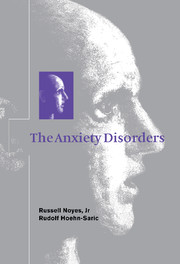Book contents
- Frontmatter
- Contents
- Preface
- 1 Normal anxiety and fear: psychological and biological aspects
- 2 Generalized anxiety disorder
- 3 Panic disorder and agoraphobia
- 4 Social phobia
- 5 Specific phobia
- 6 Posttraumatic stress disorder
- 7 Anxiety in the medically ill: disorders due to medical conditions and substances
- Index
3 - Panic disorder and agoraphobia
Published online by Cambridge University Press: 22 March 2010
- Frontmatter
- Contents
- Preface
- 1 Normal anxiety and fear: psychological and biological aspects
- 2 Generalized anxiety disorder
- 3 Panic disorder and agoraphobia
- 4 Social phobia
- 5 Specific phobia
- 6 Posttraumatic stress disorder
- 7 Anxiety in the medically ill: disorders due to medical conditions and substances
- Index
Summary
Definition
Panic disorder is characterized by attacks of extreme anxiety accompanied by sympathetic arousal. These attacks resemble the fight or flight response described by Cannon (1929) but occur in the absence of danger. During attacks, patients experience overwhelming fear and have an urge to flee or find help. With repeated attacks, they grow fearful of situations or circumstances from which escape might be difficult (e.g., confined places) or where help might not be available (e.g., when alone or a distance from home) should something catastrophic happen (e.g., heart attack, insanity). Fear and avoidance of such situations is termed agoraphobia.
Panic disorder with or without agoraphobia is the most frequent and severe anxiety disorder encountered in clinical populations. Attacks and alarming symptoms prompt many patients to seek treatment, but their somatic presentation (e.g., palpitations, shortness of breath) often causes the diagnosis to be missed. Untreated, the disorder seriously affects the quality of life and, due to chronicity, exacts heavy social and economic costs (Salvador-Carulla et al., 1995); however, with the development of precise diagnostic criteria and effective treatments, increasing numbers are receiving the help they need.
Da Costa (1871) described an affliction among soldiers of the Union Army that resembled panic. Its most constant features were palpitations, chest pain, and shortness of breath. He believed it represented an abnormal reaction to exertion and gave it the label ‘irritable heart’. In 1895, Freud published a description of anxiety neurosis, a disorder he separated from the broader category of neurasthenia that Beard (1869) had popularized.
- Type
- Chapter
- Information
- The Anxiety Disorders , pp. 86 - 157Publisher: Cambridge University PressPrint publication year: 1998
- 2
- Cited by



